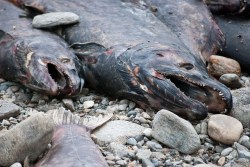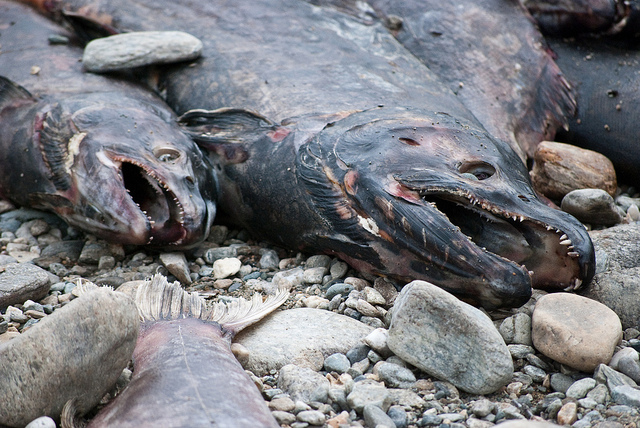
Dead salmon in British Columbia (these ones died from natural causes). (Photo by Carol Browne.)
Last month a virus broke out in an open water salmon farm in British Columbia that has the region’s fish farm owners scrambling to mitigate their losses. Called infectious hematopoietic necrosis (IHN), the rabies-like virus was found among salmon in floating net pens belonging to Mainstream Canada, the biggest producer in the region. As a result, the B.C. farm culled over 500,000 fish infected with IHN, which spreads rapidly and can kill up to 100 percent of a fish farm’s population. And this is just the latest disease scandal to hit the province’s salmon farming industry.
Critics of the industry say that the farms should have seen this coming. Their own alarm bells have been ringing ever since Rick Routledge, a professor at Simon Fraser University, claimed that wild sockeye tested by his lab in 2011 showed that another more serious virus, one that causes infectious salmon anemia (ISA), was present in B.C. waters. The government seized his samples and declared through their own testing that the virus was not present (since a verified case of the disease would be treated like other serious outbreaks such as mad cow disease under international convention, this would be devastating to the industry. In 2007, ISA caused a $2 billion loss to the Chilean salmon farming industry, and was found to be imported on Atlantic salmon eggs shipped from Norway).
Diseases like these are suspected by First Nations, activists, and fishing groups to be one cause of the drastic declines among some wild salmon populations that the province has witnessed in recent years. Home to some of the biggest wild salmon runs in the world, B.C.’s provincial government has also welcomed the salmon farming industry eagerly over the years, allowing 100 farms to be established in its waters (59 are currently in use). But activists charge that the open water pens are often located directly on the migration routes of wild salmon, where, as in the case of Chile, exotic diseases imported with the Atlantic salmon could multiply and spread into surrounding waters.
Industry figures dispute that the farms breed and spread such diseases, pointing out the Canadian government’s negative findings, but a 2011 paper in Science supported Routledge’s findings. And fellow researcher-turned-activist Alexandra Morton also maintains that the flu-like symptoms brought about by diseases like ISA can explain why millions of wild salmon die annually in B.C. rivers before they reach their spawning grounds.
Responding recently to the forced closure of the Fraser River sockeye fishery for three consecutive years, Canada convened an official inquiry that gathered dozens of researchers including Morton, government biologists, tribal members, fish farmers, and others to testify about the possible causes of the devastation. Such testimony to the Cohen Commission, as it’s called, revealed that the federal government had known about the likely presence of ISA in B.C. waters since 2006, but has kept that information secret, infuriating wild salmon defenders. The commission is due to release its findings later this year.
Lacking what they saw as a transparent governmental response to the rumors of a disease epidemic (and without cooperation from the salmon farms themselves, which refuse to share whole fish or samples with researchers), Alexandra Morton and fellow B.C. activist Anissa Reed initiated a grassroots disease testing initiative. Organizing volunteers under the banner of their grassroots group Salmon Are Sacred, the women collect wild and farmed salmon found dead along the regional waterways, buy locally farmed salmon in supermarkets, and ship the samples overnight to independent labs that specialize in salmon diseases.
The shipping and testing can cost up to $400 per fish, but they’ve claimed it has established evidence linking the B.C. samples with the disease that has forced the closures of entire areas of Chile and Norway to salmon farming in recent years. In April, these same independent tests revealed yet another exotic salmon virus in 100 percent of Salmon are Sacred’s B.C. samples. That virus, piscine reovirus (PRV), has been linked to disease that causes heart and skeletal muscle inflammation (HSMI). PRV is common in both wild and farmed species, but activists fear the concentrated populations of fish on the farms may make them more susceptible to HSMI because it weakens their hearts. The federal government then told the media that it has known of the presence of this virus on B.C. salmon farms since 2010, but maintained that it isn’t a threat to consumers or wild fish.
But many suspect that diseases caused by PRV are an additional factor in the decline of wild salmon. Alexandra Morton is unequivocal about it. “Up to 90 percent [of salmon] are vanishing in the river as they swim through extreme rapids, and 75 to 100 percent of the farm salmon they have to pass [en route] have a disease that spreads like ‘wildfire’ and causes heart failure,” she says.
Salmon are Sacred has attracted a lot of attention for suggesting such links, earning the disapproval of both government and industry. Perhaps in reaction, a bill was recently proposed by the B.C. government that activists say could have made such citizen testing programs illegal. Industry sources countered that Bill 37 would have only muzzled government employees, not citizens, regarding ongoing disease research. Regardless of how each side’s lawyers were reading it, the bill was withdrawn soon after a very public outcry.
Back at sea, the salmon farm industry says that last month’s outbreak of IHN (which occurs naturally in wild Pacific salmon but has caused massive die-offs of farmed Atlantic salmon) is now under control.
Activists say it’s likely that some of the infected fish went for sale in grocery stores (signatures on a general online petition about farmed salmon shot up after the incident) while the salmon farming industry maintains that all the fish were composted. The nets are being quarantined and sanitized, too, but IHN has also now been found infecting a salmon farm in adjacent Washington state, forcing the destruction of all of its fish.
Many, including Routledge, question whether quarantining the farms can be effective.
“Since viruses cannot be kept from spreading from net pens [into] surrounding waters, and since small salmonids can themselves pass through the nets, an infected farm cannot be effectively quarantined,” he says. Yet industry sources like Colleen Dane of the B.C. Salmon Farmers Association disagree. “Given the quick actions of the company and the fact that follow-up testing has shown 50 other farms do not have the virus, it appears so far that the quarantines have been effective,” she says.
Viruses aren’t the only way that salmon farms can affect wild salmon populations. Farmed escapees could compete with wild salmon for forage, and they also spread parasitic sea lice that kill juvenile wild salmon. Activists say the industry responded to this revelation by increasing its open water application of the pesticide Slice, which has reduced the populations of the parasite, with unknown ecological impacts. Meanwhile, the industry claims that farms have reduced the use of the SLICE.
To salmon farm opponents, the only answer to this situation is closed containment, and they have renewed their call to move all B.C. farmed salmon into tanks on land where disease and parasite loads can be controlled. In recent years, the chorus of voices for containment has grown considerably, marking a high point in 2010 when 10,000 people marched the length of Vancouver Island in support of this move, calling it the “Get Out Migration.”
Many salmon are already grown in such scenarios in B.C. — hatcheries culture juveniles until they are large enough to make the trip to the open net pens offshore. And companies, including the one that suffered the recent disease outbreak, have indicated interest. “Mainstream is currently looking at this alternative for grow-out operations through our research station in Norway, and is following the prototypes for containment in Canada,” Laurie Jensen, Mainstream’s Communications and Corporate Sustainability Manager, told me by email. But, she continued, “The operating cost to grow salmon to five kilos is not environmentally, socially, or economically sustainable at this time due to the increased carbon footprint required for land-based saltwater grow-out.”
Indeed, even closed containment has its critics. As marine biologist Daniel Pauly of the University of British Columbia Fisheries Center told me, on-land containment is “an answer to the pollution, parasite, and disease problems, not to the deeper issues connected with farming carnivores.” The larger question of whether the oceans’ dwindling stocks of sardines and other forage fish can support the salmon farm industry for long, on land or otherwise, is even thornier than the disease problem.
Update: This story was amended to include the number of salmon farms currently in use (versus those that have licenses), and to reflect the salmon farming industry’s claims that sick fish were composted, and the use of SLICE has gone down.


